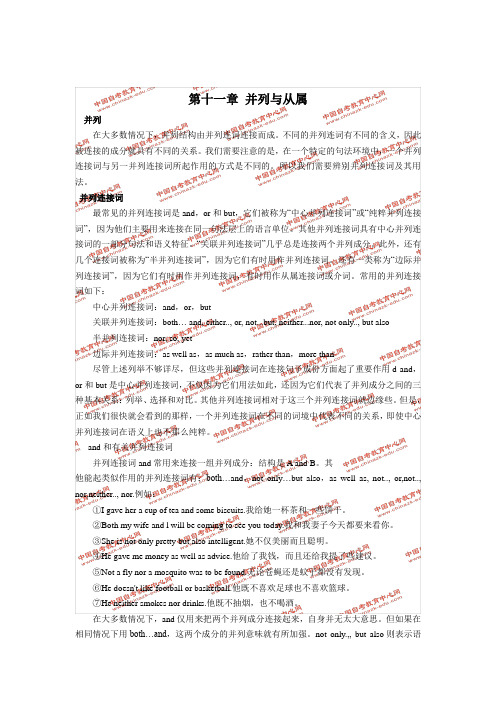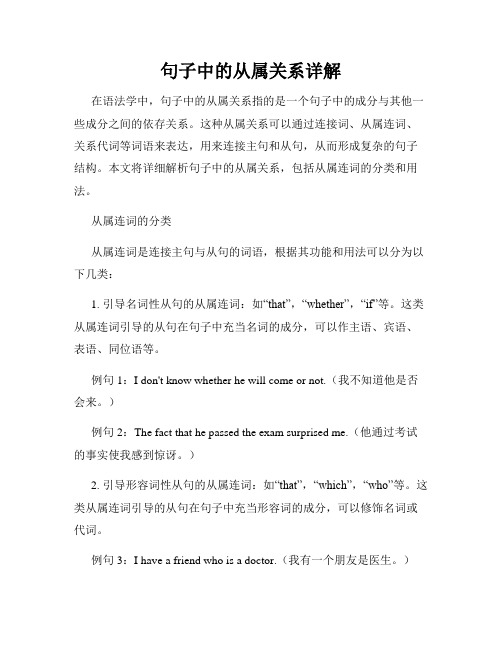从属结构英语句子精品讲解(2014年7月4日)
《英语语法》第十一章 并列与从属

第十一章并列与从属并列在大多数情况下,并列结构由并列连词连接而成。
不同的并列连词有不同的含义,因此被连接的成分就具有不同的关系。
我们需要注意的是,在一个特定的句法环境中,一个并列连接词与另一并列连接词所起作用的方式是不同的。
所以我们需要辨别并列连接词及其用法。
并列连接词最常见的并列连接词是and,or和but,它们被称为“中心并列连接词”或“纯粹并列连接词”,因为他们主要用来连接在同一句法层上的语言单位。
其他并列连接词具有中心并列连接词的一部分句法和语义特征。
“关联并列连接词”几乎总是连接两个并列成分。
此外,还有几个连接词被称为“半并列连接词”,因为它们有时用作并列连接词。
还有一类称为“边际并列连接词”,因为它们有时用作并列连接词,有时用作从属连接词或介词。
常用的并列连接词如下:中心并列连接词:and,or,but关联并列连接词:both… and, either.., or, not...but, neither...nor, not only.., but also半并列连接词:nor, so, yet边际并列连接词:as well as,as much as,rather than,more than尽管上述列举不够详尽,但这些并列连接词在连接句子成份方面起了重要作用d and,or和but是中心并列连接词,不仅因为它们用法如此,还因为它们代表了并列成分之间的三种基本关系:列举、选择和对比。
其他并列连接词相对于这三个并列连接词就边缘些。
但是,正如我们很快就会看到的那样,一个并列连接词在不同的词境中代表不同的关系,即使中心并列连接词在语义上也不那么纯粹。
and和有关并列连接词并列连接词and常用来连接一组并列成分:结构是A and B。
其他能起类似作用的并列连接词有:both…and,not only…but also,as well as, not.., or,not.., nor,neither.., nor.例如:①I gave her a cup of tea and some biscuits.我给她一杯茶和一些饼干。
专四练习之语法从属结构

2.关系代词which, that ,as 引导的定从的用法 1)关系代词在定从中作宾语时可省略。 2)先行词是不定代词时(all, any, anything,
everything, few, little, much, none, nothing, some, something),关系代词只能用that。关系代词在定 从中作宾语时可省略。
3)在否定转移结构中,主句谓语动词表示 “认为,相信,猜测”等,如果后面的宾 语从句中含有否定词not,通常要将not转移 到主句谓语上。这些词包括believe,
consider, expect, fancy, guess, imagine, reckon, suppose, think等。
二.关系(定语)从句要点提示
6)表语从句用于系动词be/look/seem /remain之后, 对句子主语进行解释和 说明。当句子主语为reason时,表语从句 应当由that而不是because来引导,但可以 说it/this/that is becat引导的宾 语从句,但以下几个介词除外: besides(that) /but(that) /except(that) / in(that).这些介词和后面的that已被当成固 定的复合连接词使用。
2)能接同位语从句的常用名词包括:answer, belief, certainty, concept, conclusion, decision, discovery, doubt, evidence, explanation, fact, hope, idea, impression, information, knowledge, law, likelihood, message, news, order, opinion, possibility, principle, probability, problem, promise, proof, question, reply, report, rumor, statement, suggestion, thought, truth等。
句子中的从属关系详解

句子中的从属关系详解在语法学中,句子中的从属关系指的是一个句子中的成分与其他一些成分之间的依存关系。
这种从属关系可以通过连接词、从属连词、关系代词等词语来表达,用来连接主句和从句,从而形成复杂的句子结构。
本文将详细解析句子中的从属关系,包括从属连词的分类和用法。
从属连词的分类从属连词是连接主句与从句的词语,根据其功能和用法可以分为以下几类:1. 引导名词性从句的从属连词:如“that”,“whether”,“if”等。
这类从属连词引导的从句在句子中充当名词的成分,可以作主语、宾语、表语、同位语等。
例句1:I don't know whether he will come or not.(我不知道他是否会来。
)例句2:The fact that he passed the exam surprised me.(他通过考试的事实使我感到惊讶。
)2. 引导形容词性从句的从属连词:如“that”,“which”,“who”等。
这类从属连词引导的从句在句子中充当形容词的成分,可以修饰名词或代词。
例句3:I have a friend who is a doctor.(我有一个朋友是医生。
)例句4:This is the book that I mentioned yesterday.(这是我昨天提到的那本书。
)3. 引导副词性从句的从属连词:如“when”,“where”,“because”,“although”等。
这类从属连词引导的从句在句子中充当副词的成分,可以修饰动词、形容词或副词。
例句5:She always calls me when she needs help.(她需要帮助时总是给我打电话。
)例句6:Although it was raining, we still went out.(尽管下雨了,我们还是出去了。
)从属连词的用法从属连词具有特定的用法规则,以下是常见的几种用法:1. 引导名词性从句的从属连词的用法:a. “that”可以引导宾语从句,并且在口语中常被省略。
从属结构知识点总结

从属结构知识点总结属结构是语法学中的一个非常重要的概念,主要用来描述词汇之间的关系。
在属结构中,一个词或短语被另一个词或短语所修饰或限制。
这种修饰关系可以在名词和形容词之间、形容词和名词之间、动词和名词短语之间等等。
属结构不仅在英语中广泛应用,在其他语言中也存在。
本文将总结属结构的基本概念、分类、特点和应用,并提供一些相关的例子来帮助读者更好地理解这一语法现象。
基本概念属结构是语法学中的一个重要概念。
它描述了一个词或短语如何被其它词或短语所修饰或限制。
在属结构中,有一个主要的词(被修饰的词)和一个或多个修饰词(修饰或限制的词)。
这种关系可以在名词和形容词之间、形容词和名词之间、动词和名词短语之间、副词和形容词之间等等。
另外,属结构通常由两部分组成:主要成分和修饰成分。
主要成分是被修饰或限制的词,修饰成分是用来修饰或限制主要成分的词。
分类根据主要成分的不同,属结构可以分为名词属结构、形容词属结构、动词属结构、副词属结构等。
其中,名词属结构是最常见的一种。
在名词属结构中,名词作为主要成分,而形容词、代词、名词短语等则作为修饰成分。
比如,在句子“the big house”中,“house”是主要成分,而“the”和“big”则分别是修饰成分,构成名词属结构。
特点属结构具有以下几个特点:1. 修饰和被修饰的词之间存在一种从属关系,修饰词限制或描述着主要成分。
2. 通常来说,主要成分在前,修饰成分在后。
比如,在名词属结构中,主要成分(名词)位于前面,修饰成分(形容词、代词等)位于后面。
3. 修饰成分可以有多个,以扩展对主要成分的描述和限制。
比如,在句子“the bi g old house”中,“big”和“old”都是修饰成分,用来修饰主要成分“house”。
应用属结构在书面语和口语中都有广泛的应用。
它可以用来描述一个词或短语的特征、属性、状态等,从而丰富语言的表达效果。
以下是一些常见的属结构的应用场景:1. 名词属结构名词属结构通常用来描述一个名词的特征或属性。
从属结构之从句篇

❖ OR: It has not been decided if we'll make a loan for the project . (错误)
2)作介词的宾语,
❖ I have no idea about whether I can raise the money for
❖ He had told me that he would join the club sometime .
❖ 他曾经告诉我说,他会在某个时候参加俱 乐部的。
❖ I remembered that I had met him somewhere .
❖ 我记得我曾在哪儿见过他。
❖ She thought that she would have finished what she was doing by the end of the month . 她认为在那个月底她将完成 她手头上做的事。
can may
间接
that those there then go take could
might had to
直接
时 three years ago 间 last year 状 last week
this year
语 next week next year today yesterday tomorrow
morning helps her a lot in the improvement of her English study .
要点提示 在使用主语从句中,有几个问题值得我们注意:
❖ 1)尽管主从连词that在主语从句中没有任何 意义,但一般不能省略。
英语从属连词用法分类详解

英语从属连词用法分类详解1. 引导时间状语从句的从属连词(1)表示“当…时候”或“每当”的时间连词。
主要的 when, while, as, whenever:He jumped up when the phone rang. 铃响时他吓了一跳。
We listened while the teacher read. 教师朗读时我们听着。
The phone rang just as I was leaving. 我正要离开,铃就响了起来。
(2)表示“在…之前(或之后)”的时间连词。
主要的有before, after:Turn the lights off before you leave. 离开前请关灯。
He started the job soon after he left the university. 他大学毕业后就开始做这份工作。
(3)表示“自从”或“直到”的时间连词。
主要的有since, until, till:He has lived here since he got married. 他结婚后就一直住在这儿。
Most men worked u ntil [till] they’re 65.大多数男人工作到65岁。
(4)表示“一…就”的时间连词。
主要的有as soon as, the moment, the minute, the second, the instant,immediately, directly, instantly, once, no sooner…than, hardly…when等:Tell him the news as soon as you see him. 你一见到他就把这消息告诉他。
I recognized her the moment (that) I saw her. 我一看到她就认出她来了。
I want to see him the minute (that) he arrives. 他一到来我就要见他。
从属结构(一)1

c)关联从属连词
由两个关联词构成的从属连词叫关联从属 连词,如as…as, as…so, barely / hardly /scarcely…when, more / (-er) /less… than, no sooner…than, not so…as, so… that, such…as, such…that, the…the, whether…or等。
如以第一句为第二句的否定条件状语,就是: Unless air traffic is closely controlled, flying is relatively unsafe. 如以第一句为第二句的让步状语,就是: Although / Even though air traffic is closely controlled, flying is relatively unsafe. 或者说: Whether or not air traffic is closely controlled, flying is relatively unsafe.
1.并列与从属 并列与从属是两种不同的连接手段。从语义 上看,两个分句所表示的意义,在说话人看来, 如果具有同等重要性,就可以把它们并列起来, 连成一个并列句。
The rain stopped, and the sun came out. 如果在说话人看来,“太阳出来”是他最关心 的事情,那就可以通过从属手段连成一个复杂 句: the rain stopped, the sun came out. When 由此可见并列与从属两个分句之间的句际 语义关系。
也可以用非限定分句和无动词分句。
Expecting trouble, the guards were fully armed.
语法:从属结构

当然since/as分句也可以位于句尾,作为一 种补充说明。 e.g. I’ll have to ask someone else, since you can’t answer this question.
c) 原因状语分句还可以由in that,now that, seeing that等复杂连词引导。
说明原因:
It must be very late, because/for the streets are equal deserted.
b)在because,since,as这三个从属连词中, 以because语势最强,since次之,as又次之。
由于since/as分句通常表示一致的原因,所 以常常出现于句首,这又是它们与for分句不同 之处。
d)原因状语分句还可由on the ground(s) that,for the reason that ,by reason that, for fear (that)等边际从属连词引导
3、关于so that与so…that结构
a)两种结构中that在非正式语体中可以省略
b)so…(that)结构只能表示“结果”,而so (that)结构可表示“结果”和“目的” e.g. We all arrived at eight, so (that) the meeting began promptly. (结果)
初中英语语法之从属连词详细解析

初中英语语法之从属连词详细解析从结构上说,英语连词分两大类:并列连词和从属连词。
并列连词连接两个或两个以上地位平等的字、词组或分句。
而从属连词,连接两个或两个以上的分句,以此来形成复杂句中的从属分句。
其引导的句子与主句的地位不平等,处在从属的地位,因此称之为从属连词。
从属连词主要用来引导名词性从句和状语从句。
名词性从句主要有:主语从句、宾语从句、表语从句和同位语从句;而状语从句主要有时间、条件、目的、结果、原因、让步、方式、地点和比较状语从句。
各种从句的连词主要如下表所示:以上连词的用法主要如下:1.名词性从句:(1)that,if和whether:that表示肯定、确定之意;if和whether译为是否,含有否定、不确定之意。
Whether he will come here is still unknown to us.我们还不知道他来不来。
I doubt(whether)if the answer is right.我怀疑这答案是否正确。
I dont doubt that the answer is right.我不怀疑这答案是正确的。
(2)if和whether:引导宾语从句时,两者可互换;引导主语、同位语和表语从句时,只能用whether,不能用if。
宾从:He wanted to know whether(if)they could help him.他想知道他们能否帮他。
主从:Whether you will come or not doesnt matter.你来不来都无所谓。
同从:They are discussing about the question whether it will rain tomorrow.他们在讨论明天会不会下雨这个问题。
表从:The question is whether he will come here.问题是他会不会来。
2.状语从句:(1)时间:We were about to leave when it began to rain.就在我们要离开时,天开始下雨。
语法——从属结构一

He was held responsible for the fact that his dog had bitten his neighbor.
It is impossible to disguise the fact that business is bad.
用陈述句的语序。例如: She asked whether/if I could speak French.
She didn’t say whether/if she’d go or stay at home. Tell me whether/if you like it or not. I am wondering whether or not we will get there in
3. That 从句作宾语 That 从句最普通的用法是作某些动词的宾语。例如: He complained that his meal was cold.
Evidence indicated that the experiments were unsuccessful.
少数几个介词后可以接 that 从句充当宾语,如 except that, but that, save that, in that:
从属结构可以是词组(主要是介词词组),也可以是限定分 句、非限定分句或无动词分句。
限定从属分句
限定从属分句就是以限定动词词组作谓语动词的从属分句。 例如:
What caused the fire is still a mystery.
主语,名词性分句 The man who did the robbery has been caught.
He told me (that) he would go fishing tomorrow afternoon and that he would invite Mary to go with him.
专四练习之语法(从属结构)

目 录
• 从属结构的定义和分类 • 名词性从句 • 定语从句 • 状语从句 • 虚拟语气在从属结构中的应用
01
从属结构的定义和分类
定义
总结词
从属结构是指句子中的一个或多个成分作为另一个成分的附属,从属于主句。
详细描述
在英语语法中,从属结构指的是一个或多个子句作为另一个子句的附属成分, 从属于主句。这些子句可以是形容词从句、名词从句或副词从句,它们通过连 接词与主句建立关系,形成复杂的句子结构。
虚拟语气在宾语从句中的应用
总结词
在宾语从句中,虚拟语气用于表达对未来的想象或建议。
详细描述
在宾语从句中使用虚拟语气时,通常是在描述对未来的设想或建议。这种用法常出现在 动词后的宾语从句中,用以表达对未来的期望或建议。例如,“我希望我能成为一名优 秀的教师。”在这个句子中,“我希望”引导的宾语从句使用了虚拟语气,表示对未来
的期望。
虚拟语气在表语从句中的应用
要点一
总结词
要点二
详细描述
在表语从句中,虚拟语气用于表达与事实相反的情况或假 设。
在表语从句中使用虚拟语气时,通常是在描述一个与主句 内容相反的假设或条件。这种用法常出现在形容词或名词 后的表语从句中,用以补充说明主句的内容。例如,“他 的建议是,如果我们早点开始,就能完成这项任务。”在 这个句子中,“如果我们早点开始”是虚拟语气在表语从 句中的应用,表示与主句内容相反的假设条件。
03
定语从句
前置定语
总结词
修饰名词或代词,放在被修饰词之前。
详细描述
前置定语通常由形容词、形容词性短语或形容词性从句充当,放在被修饰的名词或代词之前,用以描述名词或代 词的性质或特征。例如,“美丽的风景”中的“美丽的”就是一个前置定语。
从属结构(名词性从句)

A • 4._____ she could not understand was______ fewer and fewer students showed interest in her lessons. • A What, why • B That, what • C What, because • D Why, that 第一个空为what引导的主语从句,what在从句中 做understand的宾语。第二个空为why引导的表语从句
• Before she could answer the telephone, it stopped ringing. 时间状语从句 • John, who comes from a large, lower-class family, enrolled in college this fall.
2 Do you know who they are waiting for? 3 Pay attention to what the teacher said. 4 We came to where he lived. 宾语从句就是在复合句中作宾语的名词性从句, 通常放在主句谓语动词或介词之后。
1. 我怀疑他是否会说英语。
无动词分句
从属连词:从属分句的连接手段
• • • • 简单从属连词 (one-word subordinator) 复杂从属连词 (以 that / as 结尾) 关联从属连词 边际从属连词
注:区分关系词 P 381 关系代词:who(ever), whom, whose, what(ever), which(ever). 关系副词: where, when, how, why 关系限定词
英语的句子结构(三)从属结构

英语的句子结构(三)从属结构前面我们讲到句子的并列结构。
下面几节来谈谈英语句中最常见也是最复杂的另一种结构:从属结构定义:按层次分析法,如果句子语法结构中含有同一层次或更高层次的结构作为它的直接成分。
这样结构的句子称为从属结构结构分类:单一的限定分句,非限定分句,无动词分句,简单的一个词组。
与并列比较:联系:并列和从属都是连接分句或词组的两种不同的手段。
区别:并列结构中两个分句所表示的意义对说话人来讲,地位是相等的,所要表达的内容重要性相同。
从属结构两个或以上的分句所表示的意义对说话人来讲,地位是不相等的,是为了让次要的思想内容放在结构上的从属的位置上,从而突出句子的主要思想。
分类如下:1)次要内容放在限定从属分句中:Before she could answer the telephone ,it stopped ringing.2) 次要内容放在非限定从属分句中:Injured in saving their baby from an oncoming automobile, they are in critical condition today.3) 次要内容放在无动词分句中:Curious about their new neighbours , the James went and visited them at the first opporrunity.4) 次要内容放在不重要的词组中:Xiao Bai , the manager of the store ,is the city councilman.当然,每个句子的主从关系不是固定不变的。
主要是看说话人想要表达的主要思想是哪个分句。
如果相互改变分句出现的先后位置后表达思想的侧重点就发生改变了。
试比较:Although we find it hard to put up with the loss,we are prepared to make certain concessions.(说话人强调准备作出损失的让步)Although we are prepared to make certain concessions ,we find it hard to put up with the loss.(说话人强调难以接受这种损失)这就是从属结构的灵活和多样性。
(完整版)从属连词及状语从句

从属连词及状语从句状语从句概念:用一个句子(从句)来作另一个句子(主句)的状语,用作状语的句子就叫作状语从句。
作什么样的状语就叫什么类型的状语从句。
引导状语从句的连接词是从属连词,状语从句可以在句首,也可以在句尾。
中考主要考查状语从句的类型有:时间状语从句、地点状语从句、原因状语从句、结果状语从句、目的状语从句、条件状语从句及比较状语从句等。
1. 时间状语从句时间状语从句在主句中表示时间,常用连接词有:when(当…时),while(当…时),as(当…时),before(在…之前),after(在…之后),since(自从),not…until(直到……才),as soon as(一…就),once(一旦…就)等。
I didn’t go to bed until I finished my homework. 我直到做完作业才去睡觉。
I can listen to the radio while I work. 我可以边听收音机边工作。
(1) 时间状语从句中,一般要用一般现在时代替一般将来时,一般过去时代替过去将来时。
I will telephone you when he comes. 他来时,我会给你打电话。
(2) when引导时间状语从句,表示主句的动作和从句的动作同时或先后发生,从句的谓语可以是延续性动词,也可以是瞬间动词。
He was working when I went in. 我进去时他正在工作。
When she heard the news, she began to cry. 她听到这个消息,她哭了起来。
(3) while引导的状语从句中常用延续性动词或表示状态的动词,意为“在…期间”。
while还表示两者间的对比关系。
They rushed in while we were singing. 我们唱歌时,他们冲进来。
I like playing football, while Tom likes listening to music.我喜欢踢足球,而汤姆喜欢听音乐。
大学英语语法从属结构

B.两个同时发生的事件,如果都有延续性,而且延 续时间大致相等,用when,while。
C.两个同时发生的事件,如果都无延续性,连词可 用when,the moment,directly,immediately 等。
句 作状语 表示结果
法
so …as to, such…as,
功 能
too…to, enough…to等
B.如果unless分句本身是个否定句,那么, unless就不可以用if…not所取代。
5、关于though和although
A.一般情况下可以互换使用
B.although比though语气重,常用以强调让步 概念。
C.Though能接受even的强调,although不可以。
D.当让步状语分句指一种臆想的情况时,用 though而不用although。
We’ll come at eight so (that) the meeting can begin promptly. (目的)
c) 在正式语体中间或也能单用that表示“结果”
4、关于unless和if…not
A.由unless引导的条件状语分句既可以是真实 条件,也可以是非真实条件。作为真实条件分 句,unless通常相当于if…not。
E.引导某些倒装让步分句通常也只能用though
F.Though可在非正式语体中连接性状语, although不可以。
限定从属分句
名词性分局 形容词性分句(关系分局)
分句
属 分
非限定分句 -ing分词分句
句
-ed分词分句
不带从属连词
大学英语语法:从属结构 2

Adverbial
Clause
副词分句即状语分句,根据语意,副词分句可 分为时间、地点、条件、让步、目的、结果和 方式等。 Advebrial Clause of Time e.g Whenever I met any difficulth,he came to
my help. Until we know the facts,we can't do anything about it.
Adverbial Clause of Manner e.g You must do the exercise as I show you. She's doing her work the way I like it done. Adverbial Clause of Cause As there was no answer,I wrote again. Since the speaker can't come, we'll have to
2. 连接词 whether 引导名词性从句也不充当句子成分,但 有自己的意思,表示“是否”;引导宾语从句时,可换成 if, 但引导其他名词性从句时不能换成 if。
He asked whether [if] I would show him the way. 他问我是否可以给他 带路。 That’s why she wanted to leave. 这就是她想离开的原因。
当然since/as分句也可以位于句尾,作为一 种补充说明。 e.g. I’ll have to ask someone else, since you can’t answer this question.
从属结构之从句篇

Whether
we'll make a loan for the project has not been decided (正确) OR: It has not been decided whether we'll make a loan for the project . ( 正确) If we'll make a loan for the project has not been decided .(错误) OR: It has not been decided if we'll make a loan for the project . (错误)
名词从句中的从属连词在从句里不担任任
何成分,只起连接的作用;而关系代词和 关系副词不仅仅是起连接的作用,而且还 在从句里担任一定的成分;关系代词常在从 句中担任主语、宾语或表语等成分;关系 副词常在从句中担任状语。
另外,在使用上面的这些关系词时,有几个问题 值得我们注意:首先,只能用whether而不能用if 的情况.
“I‟m sorry,” the professor said to the class, “but none of you watched carefully enough.”
用自己的话转述别人所说的内容。通常 以宾语从句的形式出现。当直接引语变 为间接引语时,有关的人称、语序、时 态、代词、时间状语、地点状语、和少 数动词都要作相应的改变。
three years before the year before the week before that year the next week the following year that day the day before The next day
从属结构

从属结构II. Learning Points1.Clause of Time:when, after, before, until①when, after, before, until,在用于两个先后发生的事态时,可以互换使用。
例如When I reached the station, the train had already left. =I reached the station afte r the train had left.=I did not reach the station until /after the train had left.=The train had left before I reached the station.②两个同时发生的事件,如不是一次性而是重复性,即过去或现在的习惯当中,可用if, when, whenever 互换。
例如:If he goes to town, he brings us a present. (p.528)= When / Whenever he goes to town, he brings us a present.③两个同时发生的事件,如都有延续性,且延续时间大致相等,用when, while。
例如:The wind blew hard when the rain poured down. While I read, she sang.2. Clause of Cause: because , for, since, as, now that①表示直接理由,可以用because , for。
例如:We hurried because / for it was getting dark.Notes: because 位置较灵活,可置于主句前,也可置于其后;for的位置较固定,置于主句之后。
Because 还可回答why 提出的问题。
- 1、下载文档前请自行甄别文档内容的完整性,平台不提供额外的编辑、内容补充、找答案等附加服务。
- 2、"仅部分预览"的文档,不可在线预览部分如存在完整性等问题,可反馈申请退款(可完整预览的文档不适用该条件!)。
- 3、如文档侵犯您的权益,请联系客服反馈,我们会尽快为您处理(人工客服工作时间:9:00-18:30)。
12
Prepositional Phrases 介词短语 for showing minor ideas
• If the speaker wants to further minimize the importance of the minor idea, he can even put it in a phrase, chiefly a prepositional phrase, eg: With curiosity, the Johnsons went and visited their new neighbors at the first opportunity.
10
Non-finite clauses for showing minor ideas 非限定从属分句
• 当你横过马路时,一定要小心。 • While crossing the street, you must be careful. • 在显微镜下观察,刚飘下来的雪花呈精巧的六 角形。 • Seen under a microscope, a fresh snowflake has a delicate six-pointed shape. • 我据顶不打电话而是写信。 • I decide to write rather than (to) telephone.
15
Simple subordinator 简单从属连词
Also known as one-word subordinators
• • • • • • • after although because before directly for if • • • • • • • immediately lest like since that though till • • • • • • • unless until when(ever) where(ver) whereupon while whilst,etc
6
Ways of subordinating minor ideas
把次要思想置于从属地位的方法
• It is a general practice to put the main idea in the main clause主句 and the minor idea in a dependent clause 从句(= subordinate clause). • There are various ways of subordinating minor ideas, which may be expressed by a – finite clause 限定从属分句 or – non-finite clause 非限定从属分句 or – verbless clause 无动词分句.
18
Correlative subordinators 关联从属连词 • Subordinators of this group are composed of two correlative words
•as … as •as … so •not so … as •such … as •the … the, etc •barely /hardly/ scarcely … when •more / (-er) / less … than •no sooner … than •whether … or
13
Subordiห้องสมุดไป่ตู้ators
Section 2
14
Subordinators 从属连词
Subordinate clauses are generally introduced by subordinators, which, in terms of word formation构词法, can be classified into simple subordinators,简单从属连词 complex subordinators,复杂从属连词 correlative subordinators,关联从属连词 marginal subordinators.边际从属连词
16
Complex subordinators复杂从属连词
Also known as “multi-word subordinators” Some of these end in “that”
•assuming that •but that •considering (that) •except (that) •excepting (that) •for all (that) •given (that) •granted (that) •granting (that) •in that •in order that •insofar that •in the event that •now (that) •provided (that) •providing (that) •save that •seeing (that) •so (that) •such that •supposing (that)
11
Verbless clauses for showing minor ideas 无动词分句
如果有必要,我立刻就来。 If necessary, I’ll come at once. Main idea: the Johnsons went and visited them at the first opportunity Minor idea: (the Johnsons were) curious about their neighbors. • Curious about their neighbors, the Johnsons went and visited them at the first opportunity.
4
Coordination and Subordination 并列和从属
• Coordination(并列结构) equal importance 相同的重要性 雨停了,太阳出来了。 The rain stopped, and the sun came out. • Subordination(从属结构) one idea is more important than the other
7
Finite clauses for showing minor ideas
限定从属分句
• Before she could answer the telephone, it stopped ringing. Main idea: it sopped ringing. Minor idea: before she could answer the telephone. • 出身于下层社会的大家庭的约翰,今年秋 天考入了大学。 • John, who comes from a large, lowerclass family, enrolled in college this fall.
句子内部重要性有高下 雨停的时候,太阳出来了。
When the rain stopped, the sun came out.
5
What is subordination? 从属
• Subordination means putting a grammatical unit in a lower rank or less important position. • Words, phrases, and clauses that make one element of a sentence dependent on (or subordinate to) another. • The man with a gun in his hand is a murderer. • The man with a gun in his hand is a murderer. • The man who was holding a gun in his hand is a murderer. • The man who was holding a gun in his hand is a murderer.
Lecture 4
SUBORDINATION (I) 从句(1)
1
Subordination 从属
Coordination and
subordination并列和从属 Subordinators 从属连词 Subordinate clauses (finite) 限定从属从句 Notes on Adverbial clauses 状语从句小贴士
17
Complex subordinators复杂从属连词
Some of these end in “as” •according as •forasmuch as •as far as •inasmuch as •as long as •insofar as •as soon as •insomuch as Others include: •as if •in case •as though
限定从属分句
A. 我们准备做些让步。
We are prepared to make certain concessions. B. 我们发现难以容忍损失。 We find it hard to put up with the loss.
Emphasizing Idea B Although/ Though/ Even though/ While we are prepared to make certain concessions, we find it hard to put up with the loss.
Emphasizing Idea A Although/ Though/ Even though/ While we find it hard to put up with the loss, we are prepared to make certain concessions.
